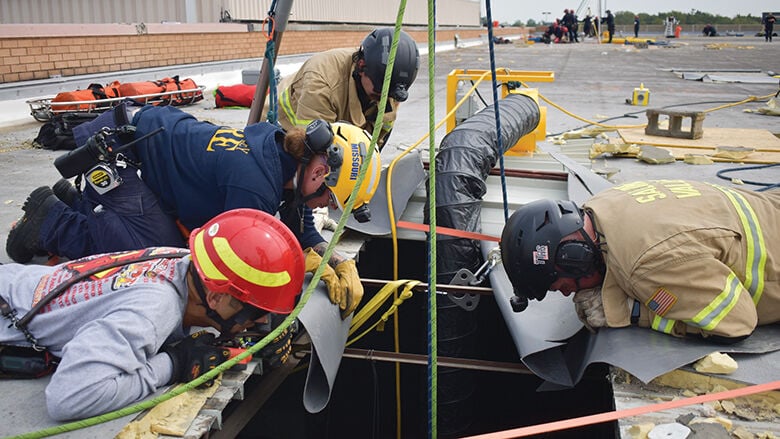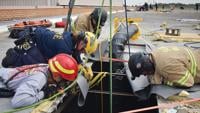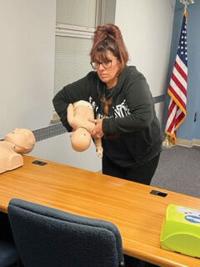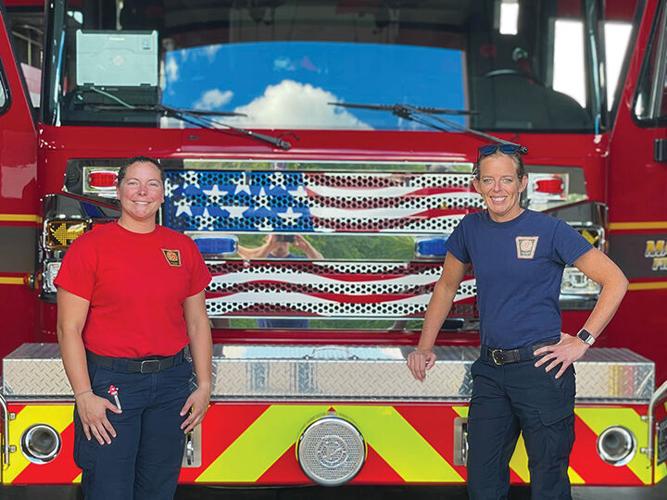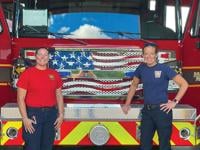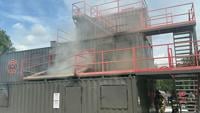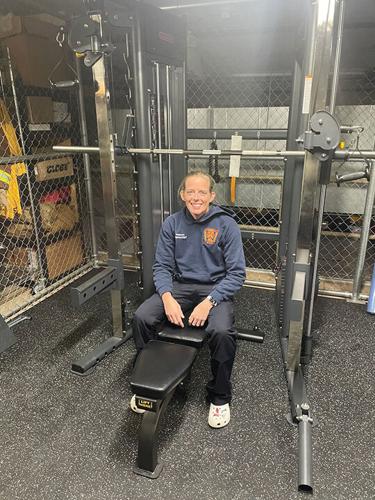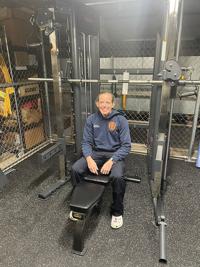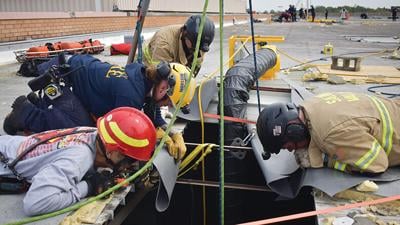On-duty firefighters never know what call will come in, so they must stay ready to spring into action at any moment.
“People are going to call us for anything, for a leaky faucet, to, literally, we responded to a person that was stuck on top of a telecommunication tower almost a thousand feet in the air,” said Mike Shafferkoetter, division chief of training for the Rock Community Fire Protection District. “We really work to be able to – maybe not be perfect at everything we do but pursue that excellence. We must be able to at least begin to mitigate and start taking care of problems, no matter what it’s going to be.”
Jeremy Lenhart, a firefighter with the Cedar Hill Fire Protection District, works on the A shift at Station 3, 8790 Byrnesville Road, in Cedar Hill.
During his 48-hour shift, Lenhart said he often must switch from having dinner or sleeping to responding to an emergency call in just minutes.
“We have a resting heart rate, and then 10 minutes later we might be fighting a fire or cutting someone out of a car,” said Lenhart, 40 of Eureka. “We’ve got to keep up with our physical fitness and be able to control that heartrate.”
Training requirements
While fire protection districts and departments in Jefferson County and Eureka require different levels of training for their firefighters, EMTs and paramedics, each agency expects its crew to stay up to date on their skills and keep physically fit, local firefighters said.
At Rock Fire Shafferkoetter said all the district’s firefighters must complete more than 200 hours of training a year to maintain its Insurance Services Office rating, which is based on hazard assessments for fire districts, and depending on the rating, could result in lower insurance premiums for homeowners in the district.
Rock Fire requires its firefighters to be paramedics, so those with that certification must complete additional training every five years, he said.
Missouri does not require mandatory training certifications for fire agencies; however, the state-operated Division of Fire Safety Training and Certification Unit oversees curriculums they may use.
Shafferkoetter said Rock Community Fire takes training seriously, and firefighters are encouraged to sign up for extra classes to receive certifications in areas like hazardous materials, technical rescue or operating the firetrucks.
He said on-duty firefighters try to average about two hours of training in a 24-hour period. In 2023, Rock Fire crews completed more than 14,000 hours of training. So far this year, the district has sent about 90 firefighters to classes for additional certifications. Some of these classes can take 40-80 hours to complete.
“That’s something we do that we’re very proud of here,” Shafferkoetter said. “It makes my job easy because our guys here want to do those trainings and I don’t have to try to crack a whip to get guys to do their jobs. They want to train; they want to better themselves and protect their art.”
When the Leader caught up with Shafferkoetter on Oct. 23, Rock Community firefighters were in the middle of a leadership program called “Axioms of Leadership,” which he said was designed to improve crew communications.
The training started with a PowerPoint presentation and ended outside the station where the crew had to navigate an obstacle course.
Getting creative
Fire districts are often forced to get creative to prepare their firefighters for the variety of calls they receive.
In 2022, the De Soto Rural Fire Protection District struck a deal with the Hillsboro Fire Protection District and the De Soto Fire Department to construct a shared training facility south of De Soto. The Valle Ambulance District donated the land to use for the facility.

De Soto Rural Fire Protection District firefighters brush up on their skills at the shared fire rescue training facility north of De Soto.
De Soto Rural Fire Chief Tom Fitzgerald said the deal is not only a cost-savings measure for taxpayers, but also allows the agencies to collaborate when they train, just like they do on real calls.
“(A shared training facility) is getting more common simply because everything’s so expensive, it’s difficult for especially smaller organizations like us, to just afford things on their own,” Fitzgerald said. “We were able to get the training facility now, instead of, you know, 10 years from now, when we finally saved enough money on our own.”
He said his crew uses the shared training facility about three times a week. The 3,000 square-foot facility, which cost the district $600,000, is made of shipping containers and stands three stories high.
At the facility, firefighters can simulate rescuing victims from a burning building, using hoses on a burning structure or kicking down a door, among other exercises.
A local business also regularly donates used garage door panels to the district, which allows firefighters to practice cutting into a garage, Fitzgerald said.
He said he schedules training dates with Hillsboro Fire and De Soto Fire, using a Google calendar.
“So far, we’ve had absolutely zero issues in coordinating,” he said. “With a structure fire in any of our districts, you always see a news report come out, and there’s always all of our names in there, because we’re helping each other out. We train with the people who are going to be responding in the calls.”
From Oct. 21-25, Fitzgerald said, De Soto Rural trained at Summerset Lake. While the training facility can simulate about 95 percent of what a firefighter might see on a call, there is no large body of water nearby.
So, crews were out on Summerset Lake training with new equipment that will help transport water from the lake to a fire when there is no hydrant available.
Some local firefighters also train in water rescues.
In the past 10 years, the High Ridge Fire Protection District has responded to more than 35 calls for water rescues on the Big River at the Rockford Park access point in House Springs, Fire Chief John Barton said.
Barton said almost all of his firefighters have swift water technician certifications and often schedule training on the Big River using boats, ropes, drones and sonar equipment to simulate an actual search and rescue.
“Because we average four to five rescues in that park every year, we do train quite a bit on various scenarios and what is the best and safest way to get somebody out of different locations along the rapids,” Barton said. “A river is a constantly changing and unpredictable body of water. We continue to respond down there for people who underestimate the conditions they get in, and then they wind up in a situation where they’re in trouble. They have to call for help, and so we have to deploy four stations’ worth of equipment in order to safely get them out of the situation they probably should not have been in.”
Going above and beyond
Lenhart said he ran a full 5K race, 3.1 miles, in his turnout gear, which can weigh anywhere from 45 to 75 pounds in early October, completing the race in 27 minutes and 42 seconds.
He said it was a fun challenge and a way to show support to his in-laws, who own Future Aire Heating & Air Conditioning in Eureka and sponsored the race.
On-duty or off, Lenhart said he rarely skips a run.
“Years ago, I had a little bit of anxiety and high blood pressure, and they were going to put me on medicine,” he said. “I was way too young, you know. I said, ‘No, I’m not going to do that. The way I’ll get around it is I’m going to start running,’ and I never stopped.
“(Running) helps in every aspect of my life. I don’t take any medicine; I no longer have any kind of anxiety or anything like that.”
No matter if it’s 100 degrees in July or 0 degrees in January, Lenhart said he must stay prepared to fight fires.
Cedar Hill Fire crews train for at least an hour a day and have access to weights and cardio equipment while on duty, he said.
Lenhart said training can look different every day depending on what the community needs. When the Leader spoke with him on Oct. 9, the crew was training for vehicle extrication, or the process of cutting a vehicle away from a trapped person.
“Tomorrow, we are training on a new ring removal tool, because for some reason people are getting rings stuck on their fingers,” Lenhart said.
All the training, whether it’s ring removal or cutting away a car, means firefighters have a better chance of staying calm under pressure while on an actual call, Lenhart said.
He said it could take 10-12 minutes before additional crews get to the scene of an emergency due to the rural nature of the district, meaning a shift must be fit to handle whatever emergency arises until support arrives.
“The training is critical,” Lenhart said. “If you’re out there on the fire and you’re unable to get the job done, then you are kind of part of the problem, not the solution.”

Senior Firefighter and EMT-P Stephanie Jackson, left, and Firefighter and EMT-P Kelly Isaacson on May 10, the first-ever day that Mapaville was staffed entirely by an all-female paid crew.
Teacher has second career in fire, emergency services
By Goldie Lowe
Kelly Isaacson impacts lives in more ways than one.
Isaacson, 47, of Hillsboro is a full-time Windsor High School teacher, helping ninth-grade students learn about world history.
She also works as a part-time firefighter for two fire protection districts and as a part-time paramedic for an ambulance district.
Isaacson, who has taught for the past 25 years, also is the chair of the Windsor High social studies department and has served as a Windsor summer school principal.
In 2019, she got interested in working out, which led to her second job in firefighting.
She said people at her gym were practicing for the Guns ’N Hoses boxing exhibition, which sparked her interest in training.
“Boxing’s cool. It’s a good workout,” Isaacson said.
The Guns ’N Hoses boxing exhibition, which includes mixed martial arts matches, has been held since 1987 to raise money for BackStoppers, a nonprofit organization that supports families of first responders who are killed or seriously injured in the line of duty.
“That kind of led me into the fire service because you have to be on a (fire department or district) to do that,” Isaacson said.
She started out as a volunteer firefighter at the Hillsboro Fire Protection District.
“I found when I started volunteering at Hillsboro, I just fell in love with the service,” she said. While Isaacson never ended up fighting in Guns ’N Hoses, she said she decided she wanted to invest more time in fire service.
“I found an interest in it, and that’s when I did the Jefferson County Fire Academy,” she said.
Isaacson said she started the academy in August of 2020 and obtained her Firefighter 1 and 2 certifications in 2021. She then completed the Emergency Medical Technician (EMT) Basic Course during the evenings at the Valle Ambulance District in the De Soto area in 2021, all while maintaining her teaching job.
After completing that training, she switched from volunteering as a firefighter to working as a paid part-time firefighter.
“My first part-time job was with (Chief David Brown) at (the Mapaville Fire Protection District),” she said. “He’s the one who gave me the chance and hired me part-time there.”
Isaacson said she started working as a part-time firefighter with the Mapaville Fire Protection District in June of 2021 and afterward started working as a part-time firefighter for the Hillsboro Fire Protection District as well.
Isaacson then went on to earn her Fire Service Instructor I certification in 2022, and finally received her Paramedic (EMT-P) certification in May of 2024.
Brown said Isaacson is an exceptional employee and was impressed that Isaacson was able to complete the certifications and licenses she needed while working full time as an educator and while being a mother.
He said the certifications and licenses Isaacson obtained typically take someone about two-and-a-half years to obtain, if they concentrate solely on that.
Brown said Isaacson used her vacation time at the school district to drive once a week to EMT classes in Boone County for an entire year.
“A lot of the clinical time was during the summer. A lot of it was weekends,” he said. “She would leave school on Friday, go straight to a clinical somewhere, spend pretty much all weekend doing clinicals and go back to school on Monday. She’s very driven.”
After receiving her paramedic certification, Isaacson started working part-time for the Valle Ambulance District in June.
Isaacson said she typically works at least one shift on a weekend during the school year, either a 12- or 24-hour shift.
“It’s more when I have breaks from school. Or, if I have an extra day off, I’ll pick up a shift. It’s hit or miss. In the summertime, I can work a lot more,” she said.

Mapaville Fire Protection District purchased workout equipment with funds from a $27,000 Jefferson Foundation grant that Kelly Isaacson applied for.
Isaacson said altogether, she works about 24-36 hours per month for Mapaville Fire, a little less for Hillsboro, and about 48 hours a month for Valle Ambulance.
“I don’t know how she finds the energy to do it, but I’m really proud of her and I’m proud to have her here on the staff,” Brown said.
Isaacson was more humble about her accomplishments.
“He thinks I’ve done so much. I don’t think it’s that awesome,” she said.
Brown said on top of Isaacson’s full-time teaching career and her part-time work with the fire and ambulance districts, she found time to apply for a grant for Mapaville Fire to buy new exercise equipment.
“We were awarded a ($27,060.98) grant (in November 2023) through the Jefferson Foundation for new workout equipment: a state-of-the-art treadmill; elliptical; recumbent bike; some free weights; and a Smith machine,” Brown said.
Sacrifices made
Isaacson, who has two sons, Tyler, 25, and Drew, 19, said there were times when her family had to make sacrifices while she pursued her second career.
“You give up a lot. Thankfully my boys have been patient with me as far as being supportive of it. And all the districts I work for are family friendly, so the kids could come up and have dinner with me,” she said. “I’ve been lucky. It’s a lot to balance, but it’s worth it.”
Drew, who lives in Festus, said he’s proud of his mom.
“Despite her age, four years ago she decided to volunteer for a fire department, fell in love with it, and then started literally a whole new career like five or six years before her actual retirement (eligibility),” Drew said. “I was impressed with how much she’s accomplished so late in life to completely change her whole life around and absolutely loves doing it.”
Drew said despite the challenges and sacrifices that came with the changes, seeing his mother happy and accomplishing her goals made it worth it.
He said he often spent time with her at the fire station and ended up falling in love with the field, too.
Drew has completed his Firefighting 1 and 2 certifications and recently was hired at Mapaville Fire as a part-time firefighter. He’s also a volunteer firefighter for the Hillsboro Fire Protection District and is currently going through EMT training in the evenings while attending State Technical College of Missouri in Linn to study heavy equipment operation and construction management.
Since many people who work in construction don’t have a lot of work in the winter, Drew said he plans to work more as a firefighter and EMT during that time.
He said his mother has been an inspiration to him.
“She’s probably the most dedicated person I know and always has a positive attitude about everything,” he said.
Like his mother, Drew is driven, Brown said.
Isaacson said she hopes to get the chance to work with her son.
“Maybe I can get some shifts with him, which would be awesome,” she said.
Isaacson said even though the firefighting and EMT fields tend to be male-dominated, she has not encountered any challenges based on her gender.
“I’ve been accepted 100 percent. It’s really not a big issue,” she said.
Isaacson said she encourages more women to enter the field.
“It’s the best. It’s a great career to have. It’s a rewarding career. You get the opportunity to help all kinds of people.”
Dedicated teacher
Windsor High Principal Rachel Montgomery said Isaacson is also an outstanding teacher.
“Ms. Isaacson has this amazing ability to build strong relationships with students that allow them to feel connected to Windsor High School,” Montgomery said.
She said Isaacson, a Windsor High graduate, has gone above and beyond as an educator.
“Ms. Isaacson’s commitment to Windsor High School extends far beyond her role as a mere teacher. Throughout her years at the institution, she has taken on numerous responsibilities and leadership roles, all of which have contributed to the betterment of our student body. Her dedication and expertise have been instrumental in shaping the academic and personal growth of countless individuals who have passed through the halls of Windsor High.”
Isaacson said she has no immediate plans to retire from teaching, but she’s glad she was able to find a new career she’s passionate about.
“The positive is I started teaching young so yes I was looking for something to do when I do retire, another career.”

Rebecca Valandra of Fenton participates in Rock Community Fire Protection District’s CPR class. Rock Fire holds free CPR classes and first aid classes.
Fire districts, departments offer free education, safety programs
By Tony Krausz
Fire prevention education is vital in the fire service industry, said Alyson Rotter, Rock Community Fire Protection District public education coordinator and public information officer.
“We would rather prevent it than have to respond to a fire,” she said. “Getting the preventative information to the community is vitally important.”
Personnel from the 17 fire districts and departments in Jefferson County and Eureka regularly visit schools and attend public events to teach students how to prevent fires and how to react if they find themselves in a burning building. However, the firefighters’ public appearances go beyond providing safety information.
“Outreach is huge because we want people to know us,” Antonia Fire Chief Matt Krutzsch said. “We want them to know we are here for them.”
Smoke detectors
All the districts and departments offer free smoke detectors, which were the focus of the National Fire Protection Association’s Fire Prevention Week campaign earlier this month.
Area agencies mainly team up with the Red Cross to provide free smoke detectors for homes inside their coverage areas. Firefighters from the various districts and departments even go to residents’ homes to install the detectors. Typically, residents must provide the batteries needed to operate the smoke detectors, but firefighters will go to homes to help change the batteries, which should be done at least once a year.
“That is one thing that a lot of people don’t know we do,” Rotter said. “They just have to fill out a form for Red Cross, and that is filed because smoke detectors expire after 10 years. A lot of people don’t know they expire. We are happy to provide information and make fixes to make everyone a little bit safer.”
Antonia Fire Protection District Deputy Chief Bobby Chrisco said sometimes firefighters notice that a home needs new smoke detectors when they’re on a call for a different reason.
He recalled the time when he and Krutzsch responded to a medical call to a home, and after they were finished treating the patient, they noticed some areas in the house where smoke detectors were needed.
He and Krutzsch installed the smoke detectors, and Antonia Fire was called back to the house about week later because of a kitchen fire.
“A teenager was sleeping on a couch below a newly installed smoke detector and probably wouldn’t have made it out if not for the smoke detector,” Chrisco said. “Smoke detectors are a huge thing.”
CPR, first aid classes
Among the most popular programs fire agencies offer are CPR and first-aid classes.
Rotter said Rock Fire offers a class once a month, alternating each month between offering only CPR training or offering both CPR and first-aid training.
She said those who want to attend the classes must register through the district’s website, rockfire-rescue.org, because space is limited to 15 people per class. There are no age restrictions to attend the classes, and people do not have to live in the district to take part in the classes, which are held at House 5, 3749 Telegraph Road, in Arnold.
“There is a great demand for both of them,” Rotter said. “My hope and long-term plan is to offer both once a month. An example would be every second Wednesday would be CPR and the fourth Wednesday would be CPR and first aid. I am sure we could fill two to three classes a month.”
Saline Valley Fire Protection District Chief Bob Dunn said his district does not have a regular schedule of CPR classes, but holds them when enough people express an interest.
He said the district typically holds 15 to 20 classes per year.
“I have had people call who have said I would really like to take a CPR class,” Dunn said. “I ask, ‘Do you think you can find a couple of people (to join you),’ and they typically do. Also, we may know someone else locally is hosting a class, and we will point them in that direction. It is whatever works for their needs and time schedule.”
Dunn said another important program his district and other fire agencies offer is “Stop the Bleed” classes.
“It expounds on CPR and a basic first aid class,” he said. “It is more in depth on how to stop someone from bleeding out. Sometimes if you can just stop someone from bleeding out, that could be the difference between that person living or dying.”
Outreach
Firefighters and education specialists with local fire agencies often visit schools throughout their coverage areas.
Firefighters and education specialists typically start meeting with students while they are preschoolers, and the safety programs usually continue through high school with instructors forming a relationship with students while teaching them about nearly every aspect of fire safety and first aid, Rotter said.
“It is so neat; you see the kids progress,” Rotter said. “It is cool to watch them progress through everything.”
Most districts and departments also visit businesses and community groups inside their coverage areas to provide adults with fire safety information and training.
Rotter said Rock Fire revamped its business preparedness program about two years ago, and the district is trying to get more companies to sign up for the on-site training.
“We feel it is important for the community because we can prepare businesses for any type of disaster,” she said. “They can become better prepared to respond in their business to a potential scenario. It makes their customers and employees safer.”
Dunn said it is important for residents and business owners to reach out to fire districts and departments to find out what programs are available.
He also said Saline Valley will try to provide information or programs people are interested in.
“We try to accommodate anything if people contact us and there is enough interest in something, we try to facilitate whatever our customers are wanting,” he said.
The Hematite Fire Protection District and Herculaneum Fire Department offers a program called Community Connect that allows residents and business owners in their coverage areas to enter information that may benefit first responders if they have to respond to a call at one of those homes or businesses.
“By providing information about your household that you feel is important for us to know about at the time of an emergency, we can ensure you and everything you care about is protected to the best of our ability,” Hematite Fire Chief Robert Hipes Jr. said on the district’s website, hematitefire.com.
Most of the fire districts and departments in Jefferson County and Eureka provide information on their websites and social media platforms about the programs they offer.
Those agencies also provide fire safety and prevention information on those sites.
“In the prevention aspect, we have focused on social media,” Chrisco said. “We feel that is an effective tool.”
Read more stories in the fire district series:
Click through to see all six stories related to local fire services.



